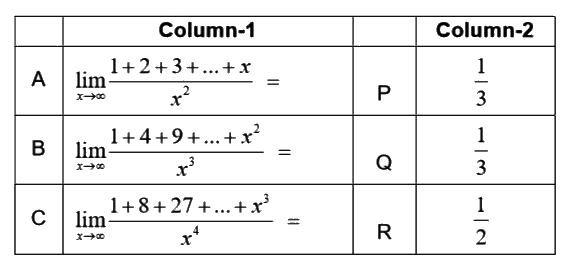Select the correct alternatives out of given four alternatives in each.
limx→πsinxx−π is-
1
2
−1
does not exists
The correct Answer is:C
To find the limit limx→πsinxx−π, we will follow these steps:
Step 1: Identify the form of the limit
We start by substituting x=π into the expression:
sin(π)π−π=00
This is an indeterminate form.
Hint: When you encounter a 00 form, consider using L'Hôpital's Rule.
Step 2: Apply L'Hôpital's Rule
Since we have an indeterminate form, we can apply L'Hôpital's Rule, which states that if limx→cf(x)g(x) results in 00, then:
limx→cf(x)g(x)=limx→cf′(x)g′(x)
Here, f(x)=sinx and g(x)=x−π.
Hint: Differentiate the numerator and the denominator separately.
Step 3: Differentiate the numerator and denominator
Now we differentiate:
- The derivative of sinx is cosx.
- The derivative of x−π is 1.
So, we rewrite the limit as:
limx→πcosx1
Hint: Substitute x=π again after differentiating.
Step 4: Substitute x=π
Now we substitute x=π into the new limit:
cos(π)1=−11=−1
Conclusion
Thus, the limit is:
limx→πsinxx−π=−1
Final Answer: The correct alternative is option 3, which is −1.
---
We start by substituting x=π into the expression:
sin(π)π−π=00
This is an indeterminate form.
Since we have an indeterminate form, we can apply L'Hôpital's Rule, which states that if limx→cf(x)g(x) results in 00, then:
limx→cf(x)g(x)=limx→cf′(x)g′(x)
Here, f(x)=sinx and g(x)=x−π.
Now we differentiate:
- The derivative of sinx is cosx.
- The derivative of x−π is 1.
limx→πcosx1
Now we substitute x=π into the new limit:
cos(π)1=−11=−1
Thus, the limit is:
limx→πsinxx−π=−1
Topper's Solved these Questions
- BOOK - CBSE COMPLEMENTARY MATERIALCHAPTER - LIMITS AND DERIVATIVES EXERCISE - SHORT ANSWER TYPE QUESTIONS10videos
LIMITS AND DERIVATIVES
- BOOK - CBSE COMPLEMENTARY MATERIALCHAPTER - LIMITS AND DERIVATIVES EXERCISE - LONG ANSWER TYPE QUESTIONS33videos
LIMITS AND DERIVATIVES
- BOOK - CBSE COMPLEMENTARY MATERIALCHAPTER - INTRODUCTION TO THREE-DIMENSIONAL COORDINATE GEOMETRYEXERCISE - SHORT ANSWER TYPE QUESTIONS20videos
INTRODUCTION TO THREE-DIMENSIONAL COORDINATE GEOMETRY
- BOOK - CBSE COMPLEMENTARY MATERIALCHAPTER - LINEAR INEQUALITIESEXERCISE - LONG ANSWER TYPE QUESTIONS (Solve to the following system of inequalities and represent solution on number line:)3videos
LINEAR INEQUALITIES
Similar Questions
Knowledge Check
- Question 1 - Select One
Select the correct alternatives out of given four alternatives in each.
limx→π4sec2x−2tanx−1 is-A0B1C2D4 - Question 2 - Select One
Select the correct alternatives out of given four alternatives in each.
limx→0(1+x)16−1(1+x)4−1 is-A0B4C8D16 - Question 3 - Select One
Select the correct alternatives out of given four alternatives in each.
limx→1x+x2+x3+x4−4x−1 is-A0B4C10Ddoes not exists
Select the correct alternatives out of given four alternatives in each.
If y=sin4x+cos4x, then dydx=View SolutionSelect the correct alternatives out of given four alternatives in each.
Math the following:

Which of the following is true?View Solutionlimx→(π)sinxx−π is equal to
View SolutionEvaluate, limx→(π/4)sinx−cosxx−π4
View SolutionIn the following questions, out of the four alternatives , out of the four alternatives, select the word similar in meaning to the word given .
MONOTONOUSView Solution

